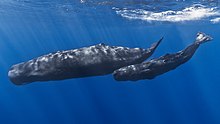Important marine mammal area

Important Marine Mammal Areas (IMMAs) are discrete portions of habitat, important to marine mammal species, that have the potential to be delineated and managed for conservation. IMMAs have been developed by the joint International Union for Conservation of Nature's (IUCN) Marine Mammal Protected Areas Task Force (MMPATF).
Definition and rationale
IMMAs are defined as discrete portions of habitat, important to marine mammal species, that have the potential to be delineated and managed for conservation.[1] ‘Important’ in the context of the IMMA classification refers to any perceivable value of an area which creates favourable conditions for marine mammals, and where it is possible to improve the conservation status of those species or populations.
The rationale for developing IMMAs includes:
- the specific vulnerability of many marine mammals,
- the fact that marine mammals have been overlooked by many national efforts to create Marine Protected Areas (MPAs),
- the role of marine mammals as indicators to support the identification of MPAs and spatial protection measures because they are more easily monitored than most other pelagic marine vertebrate species,
- the role of marine mammals as umbrella species which helps ensure that a properly designed conservation plan will be beneficial to the broader ecosystem, and
- the role of marine mammals as flagship species representing powerful political and public levers for the conservation of less popular or well-known organisms, communities, or habitats.
The intention is that the identification of IMMAs through a consistent expert process, independent of any political and socio-economic concerns, will provide valuable input of marine mammals into existing national and international conservation tools with respect to MPAs, including Ecologically or Biologically Significant Areas (EBSAs) under the Convention on Biological Diversity, and Key Biodiversity Areas identified through the IUCN.

Criteria for the selection of IMMAs

The initial criteria for identifying IMMAs were developed at the Workshop for the Development of Important Marine Mammal Area Criteria in Marseille, France, in October 2013. They were further refined in advance of the 3rd International Conference on Marine Mammal Protected Areas in Adelaide, Australia, in November 2014, and through the consultations of a working group following that conference. Finally, a public consultation was held online throughout September-October 2015 on the draft criteria, with the results of the consultation being presented at the Society for Marine Mammalogy Biennial Conference, San Francisco, in December 2015. Consideration in the selection of IMMA criteria was given to the need of IMMAs to be used for the successive identification of Ecologically or Biologically Significant Areas (EBSAs) and Key Biodiversity Areas (KBAs).[2][3] The criteria for inclusion cover sites that host vulnerable species or a significant percentage of the members of a species, sites that are important for reproduction or feeding, and sites that are home to a wide variety of species.[4]
IMMA identification process
IMMA Workshops
From 2016 onwards the major activity of the MMPA Task Force has been to organize a series of regional expert workshops tasked with identifying IMMAs in several of the world’s marine macroregions. The following seven IMMA workshops have been held to date:
- 2016 - Mediterranean region
- 2017 – Pacific Islands region
- 2018 – Extended Southern Ocean region
- 2018 – North East Indian Ocean and South East Asian Seas region
- 2019 – Western Indian Ocean and Arabian Seas region
- 2020 – Australia-New Zealand and South East Indian Ocean region
- 2021 – Black Sea, Turkish Straits System and Caspian Sea region
Current IMMAs - 173 Identified Globally
As of October 2021, 173 IMMAs have been identified following the hosting of seven expert workshops in the regions represented above. There are an additional 23 candidate IMMAs (cIMMAs) and 140 Areas of Interest (AoI). Details of all these are in the online IMMA searchable database [5] and displayed on the online e-Atlas. [6]
References
- ^ "Important Marine Mammal Areas". Marine Mammal Protected Areas Task Force. Marine Mammals Protected Areas Task Force. 2020. Retrieved 24 March 2022.
- ^ Corrigan, Colleen M.; Ardron, Jeff A.; Comeros‐Raynal, Mia T.; Hoyt, Erich; Sciara, Giuseppe Notarbartolo Di; Carpenter, Kent E. (2014). "Developing important marine mammal area criteria: learning from ecologically or biologically significant areas and key biodiversity areas". Aquatic Conservation: Marine and Freshwater Ecosystems. 24 (S2): 166–183. doi:10.1002/aqc.2513. ISSN 1099-0755.
- ^ Hoyt, Eric; di Sciara, Guiseppe Notarbartolo (22 October 2013). "Report of The Workshop for the Development of Important Marine Mammal Area (IMMA) Criteria" (PDF). Marine Mammal Protected Areas Task Force.
- ^ "IMMA Selection Criteria". Marine Mammal Protected Areas Task Force. Retrieved 6 November 2021.
- ^ "IMMA searchable database". Marine Mammal Protected Areas Task Force.
- ^ "IMMA e-Atlas". Marine Mammal Protected Areas Task Force.
